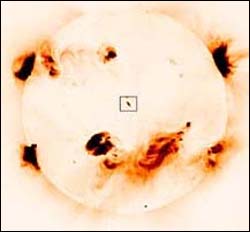This area deals with the fundamental laws and building blocks of nature and how they interact, the properties and the behavior of matter, and research into space and time and their structures.
innovations-report provides in-depth reports and articles on subjects such as astrophysics, laser technologies, nuclear, quantum, particle and solid-state physics, nanotechnologies, planetary research and findings (Mars, Venus) and developments related to the Hubble Telescope.

In a spectacular kick-off to its first season of prime ring viewing, which began last month, the Cassini spacecraft has confirmed earlier suspicions of an unseen moon hidden in a gap in Saturn’s outer A ring. A new image and movie show the new moon and the waves it raises in the surrounding ring material.
The moon, provisionally named S/2005 S1, was first seen in a time-lapse sequence of images taken on May 1, 2005, as Cassini began its climb to higher inclinations in orbit ar

Solar physicists have observed the smallest ever coronal mass ejection (CME) – a type of explosion where plasma from the Sun is thrown out into space, sometimes striking the Earth and damaging orbiting satellites. The observation has come as a great surprise to scientists and has turned previous ideas up-side-down.
To date studies of these phenomena have focussed on large explosions which are easier to detect and which have massive footprints on the Sun, sometimes covering thousan

The deployment of the second antenna boom of the Mars Express Sub-Surface Sounding Radar Altimeter (MARSIS) science experiment has been delayed pending investigation of an anomaly found during deployment of the first antenna boom.
The anomaly was discovered on 7 May towards the end of the first deployment operations. Deployment of the first boom started on Wednesday 4 May. The problem with the boom was confirmed by flight control engineers working at ESA’s European Space Operations

A major new tranche of funding is announced today by the Engineering and Physical Sciences Research Council (EPSRC). These, the first awards in the Science and Innovation Awards programme will directly build the UK’s research base in diverse areas.
The initial recipients include energy research, physical organic chemistry, statistics and electronics. Future awards will focus on other research areas. In a changing research landscape, as undergraduates choose new options, more tr

These images, taken by the High Resolution Stereo Camera (HRSC) on board ESA’s Mars Express spacecraft, show the outlet channel of the Uzboi Vallis system into Crater Holden on Mars.
The HRSC obtained these images during orbit 511 with a ground resolution of approximately 45 metres per pixel. The scenes show the region of Noachis Terra, over an area centred at about 26º South and 325º East.
The valley of Uzboi Vallis begins in the region of Argyre Planitia and crosses the southe

When University at Buffalo theorist Surajit Sen published his prediction that solitary waves, tight bundles of energy that travel without dispersing, could break into smaller, “baby” or secondary solitary waves, experts in the field acclaimed it as a fine piece of work. They also felt that these waves might never be seen experimentally.
But in a paper published this week in Physical Review Letters, Sen and his co-authors report that they have done just that. The new results contr